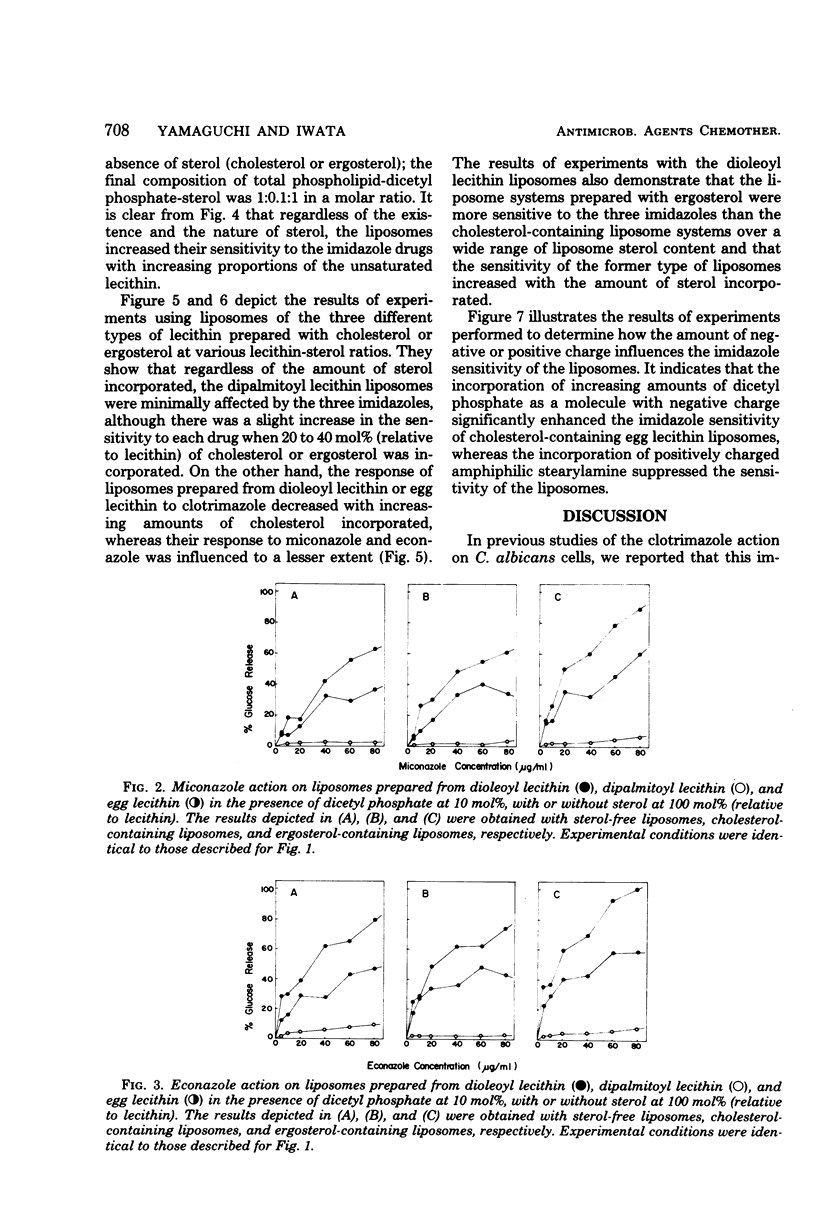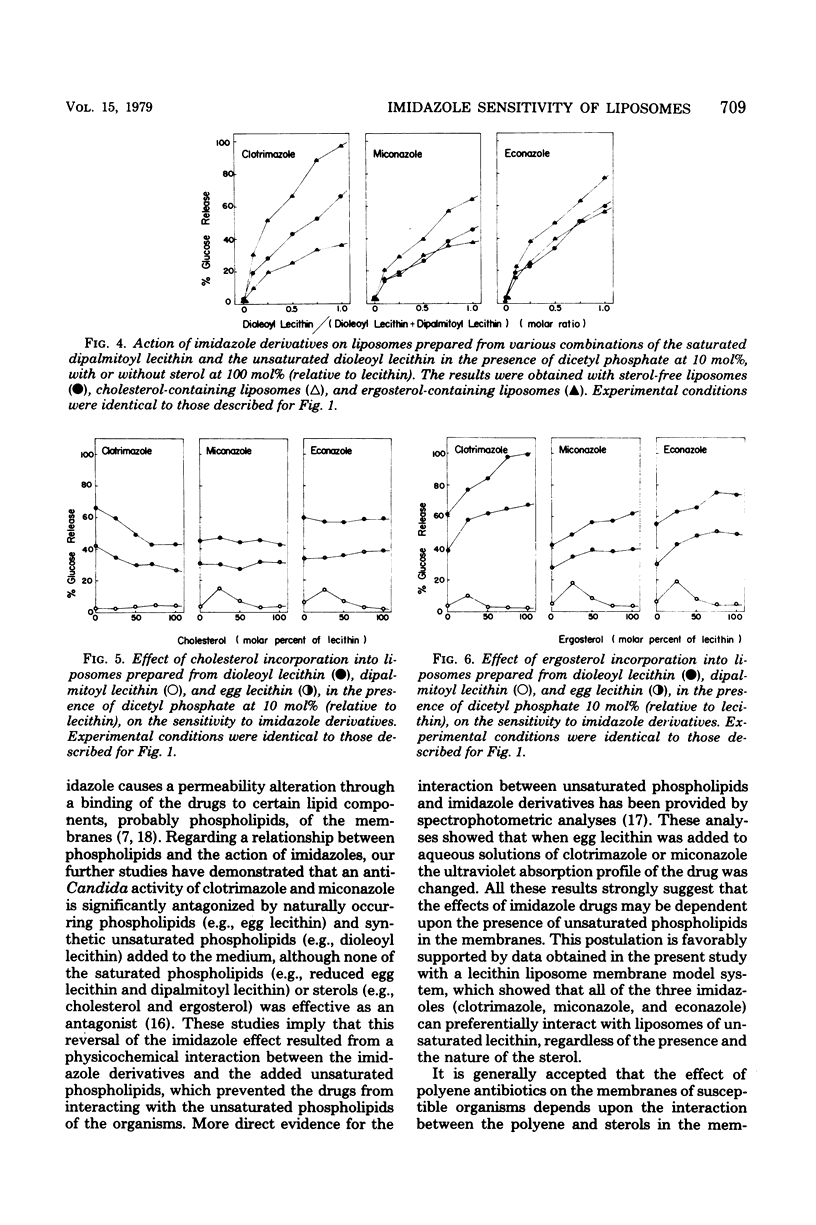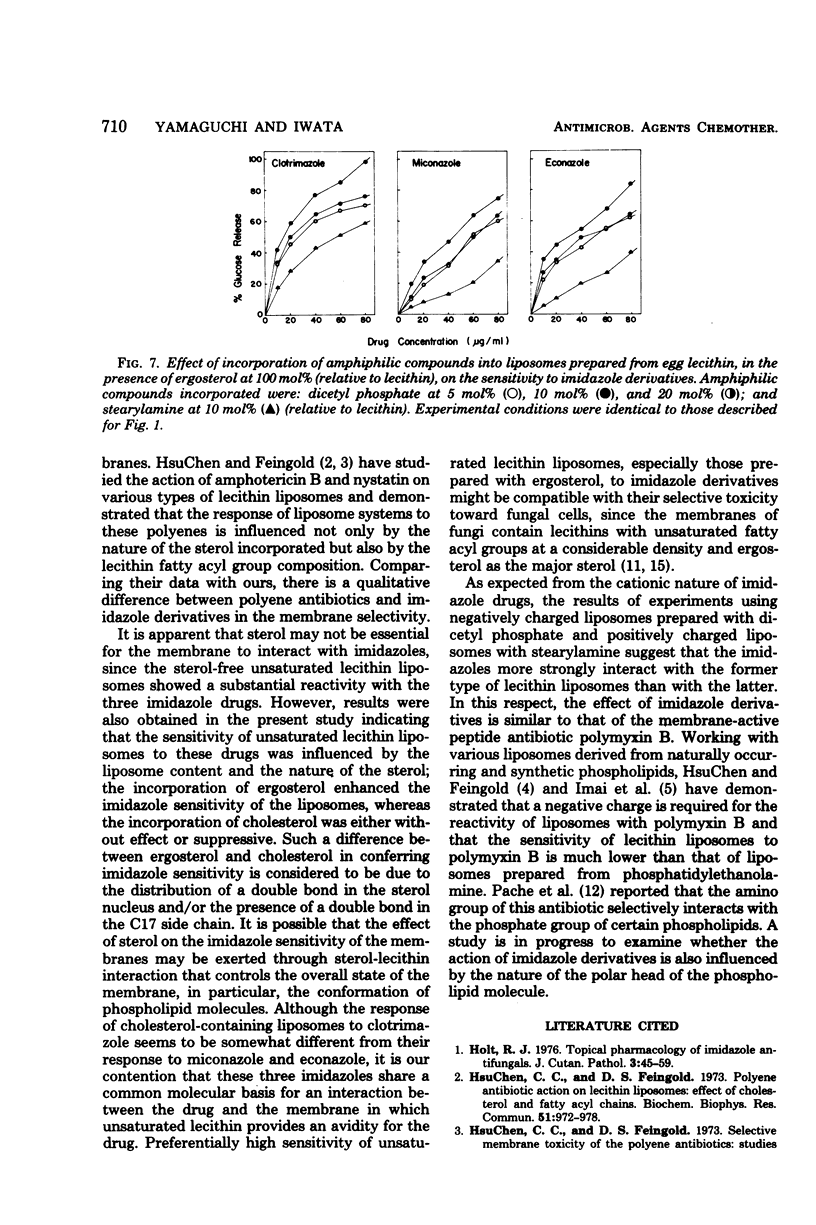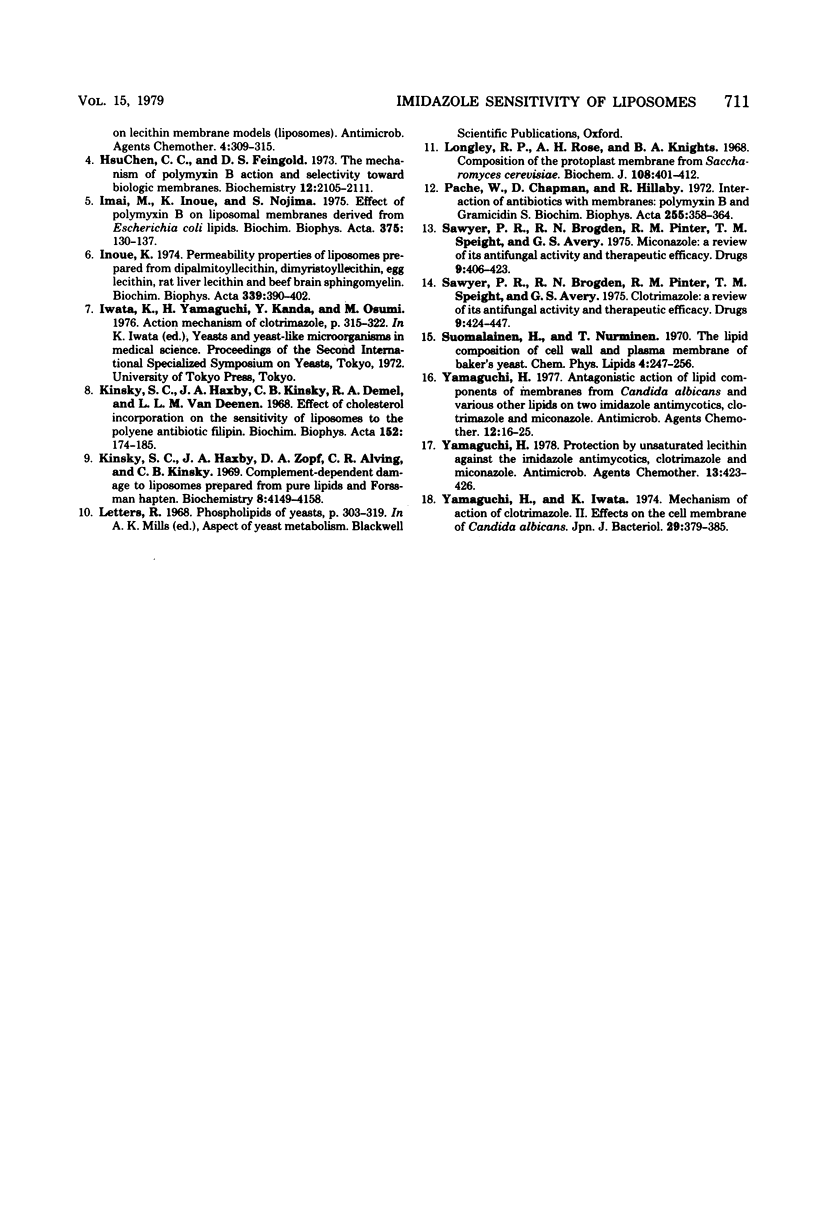Abstract
The specific affinity for membrane lipids and the membrane selectivity of three imidazole derivatives, clotrimazole, miconazole, and econazole, were studied using various types of liposomes with respect to the lecithin fatty acyl group composition and the liposome content and composition of sterol as membrane models. The sensitivity of liposomes to these drugs was primarily dependent upon the lecithin fatty acyl group composition. With sterol-free liposome systems, each imidazole induced maximum release of trapped glucose as a marker from the unsaturated dioleoyl lecithin liposomes, minimum release from the saturated dipalmitoyl lecithin liposomes, and intermediate release from egg lecithin liposomes. The sensitivity of the dipalmitoyl lecithin liposomes to any imidazole drug was not influenced by the incorporation of cholesterol or ergosterol. On the other hand, clotrimazole-induced permeability changes of liposomes prepared from unsaturated dioleoyl lecithin or egg lecithin were greatly enhanced by the incorporation of ergosterol, whereas they were suppressed by cholesterol incorporation. The sensitivity of liposomes prepared from these unsaturated lecithins to miconazole and econazole was also augmented by ergosterol incorporation, although it was scarcely altered by cholesterol incorporation. Negatively charged liposomes were more sensitive to the three imidazole drugs than positively charged liposomes.
Full text
PDF





Selected References
These references are in PubMed. This may not be the complete list of references from this article.
- Holt R. J. Topical pharmacology of imidazole antifungals. J Cutan Pathol. 1976;3(1):45–59. doi: 10.1111/j.1600-0560.1976.tb00846.x. [DOI] [PubMed] [Google Scholar]
- HsuChen C. C., Feingold D. S. Polyene antibiotic action on lecithin liposomes: effect of cholesterol and fatty acyl chains. Biochem Biophys Res Commun. 1973 Apr 16;51(4):972–978. doi: 10.1016/0006-291x(73)90022-3. [DOI] [PubMed] [Google Scholar]
- HsuChen C. C., Feingold D. S. The mechanism of polymyxin B action and selectivity toward biologic membranes. Biochemistry. 1973 May 22;12(11):2105–2111. doi: 10.1021/bi00735a014. [DOI] [PubMed] [Google Scholar]
- Hsuchen C. C., Feingold D. S. Selective membrane toxicity of the polyene antibiotics: studies on lecithin membrane models (liposomes). Antimicrob Agents Chemother. 1973 Sep;4(3):309–315. doi: 10.1128/aac.4.3.309. [DOI] [PMC free article] [PubMed] [Google Scholar]
- Imai M., Inoue K., Nojima S. Effect of polymyxin B on liposomal membranes derived from Escherichia coli lipids. Biochim Biophys Acta. 1975 Jan 14;375(1):130–137. doi: 10.1016/0005-2736(75)90078-4. [DOI] [PubMed] [Google Scholar]
- Inoue K. Permeability properties of liposomes prepared from dipalmitoyllecithin, dimyristoyllecithin, egg lecithin, rat liver lecithin and beef brain sphingomyelin. Biochim Biophys Acta. 1974 Mar 29;339(3):390–402. doi: 10.1016/0005-2736(74)90166-7. [DOI] [PubMed] [Google Scholar]
- Kinsky S. C., Haxby J. A., Zopf D. A., Alving C. R., Kinsky C. B. Complement-dependent damage to liposomes prepared from pure lipids and Forssman hapten. Biochemistry. 1969 Oct;8(10):4149–4158. doi: 10.1021/bi00838a036. [DOI] [PubMed] [Google Scholar]
- Kinsky S. C., Haxby J., Kinsky C. B., Demel R. A., van Deenen L. L. Effect of cholesterol incorporation on the sensitivity liposomes to the polyene antibiotic, filipin. Biochim Biophys Acta. 1968 Jan 10;152(1):174–185. doi: 10.1016/0005-2760(68)90019-2. [DOI] [PubMed] [Google Scholar]
- Longley R. P., Rose A. H., Knights B. A. Composition of the protoplast membrane from Saccharomyces cerevisiae. Biochem J. 1968 Jul;108(3):401–412. doi: 10.1042/bj1080401. [DOI] [PMC free article] [PubMed] [Google Scholar]
- Pache W., Chapman D., Hillaby R. Interaction of antibiotics with membranes: polymyxin B and gramicidin S. Biochim Biophys Acta. 1972 Jan 17;255(1):358–364. doi: 10.1016/0005-2736(72)90034-x. [DOI] [PubMed] [Google Scholar]
- Sawyer P. R., Brogden R. N., Pinder R. M., Speight T. M., Avery Clotrimazole: a review of its antifungal activity and therapeutic efficacy. Drugs. 1975;9(6):424–447. doi: 10.2165/00003495-197509060-00003. [DOI] [PubMed] [Google Scholar]
- Sawyer P. R., Brogden R. N., Pinder R. M., Speight T. M., Avery G. S. Miconazole: a review of its antifungal activity and therapeutic efficacy. Drugs. 1975;9(6):406–423. doi: 10.2165/00003495-197509060-00002. [DOI] [PubMed] [Google Scholar]
- Yamaguchi H. Antagonistic action of lipid components of membranes from Candida albicans and various other lipids on two imidazole antimycotics, clotrimazole and miconazole. Antimicrob Agents Chemother. 1977 Jul;12(1):16–25. doi: 10.1128/aac.12.1.16. [DOI] [PMC free article] [PubMed] [Google Scholar]
- Yamaguchi H., Iwata K. [Mechanisl of action of clotrimazole. 2. Effects on the cell membrane of Candida albicans]. Nihon Saikingaku Zasshi. 1974 Mar;29(2):379–385. [PubMed] [Google Scholar]
- Yamaguchi H. Protection by unsaturated lecithin against the imidazole antimycotics, clotrimazole and miconazole. Antimicrob Agents Chemother. 1978 Mar;13(3):423–426. doi: 10.1128/aac.13.3.423. [DOI] [PMC free article] [PubMed] [Google Scholar]


